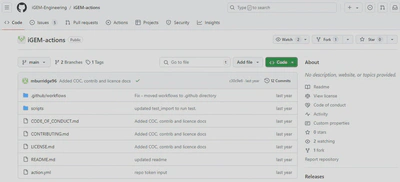🧑💻️ GitHub Actions in the iGEM Distribution repository
Jun 11, 2024· ·
4 min read
·
4 min read
Johan Guillen Meza
 Image credit: iGEM Organization
Image credit: iGEM OrganizationHi 👋
Overview
There is a centralized page that manages the iGEM Engineering organization GitHub Actions.

The idea is that the different iGEM packages(i.e. Plants, Anderson Promoters etc) will have their own repository and within them, the iGEM Actions will be called.
Let’s breakdown the code in the action.yml file that is in the repository. This file is in charge or running the actions when they are called from other repositories.
This GitHub Action workflow file is designed to automate a series of tasks to generate a distribution from user-readable files. Below is an explanation of each part of the workflow:
Workflow Metadata
- name: generate-distribution - The name of the GitHub Action.
- description: Describes what the GitHub Action does - “A Github action to generate a distribution from user-readable files.”
Inputs
- repo-token:
- description: The GitHub token used to manage committing and pushing changes.
- required: true - This input is mandatory for the action to run.
- default: ${{ github.token }} - Default value is the GitHub token provided by the GitHub Actions runtime.
Runs
- using: composite - Indicates that this is a composite action composed of multiple steps.
- steps: Each step in the composite action.
Steps
- Check out this repository for building
- Uses actions/checkout@v3 to check out the repository so that the workflow has access to the code.
- Set up Python 3.9
- Uses actions/setup-python@v4 to set up Python 3.9.
- Set up Node.js 14
- Uses actions/setup-node@v3 to set up Node.js 14.
- Install dependencies
- Uses bash to run commands to upgrade pip and install dependencies listed in scripts/requirements.txt.
- Regularize directories
- Uses bash to run a Python script regularize_directories.py to standardize directory structure. The script ensures that packages directories are non-nested, that there is one Excel file per package, and that every package directory has a views subdirectory for storing generated artifacts.
- Update CSVs
- Uses bash to run a Python script export_csvs.py to update CSV files. The script exports a CSV from each user tab of a package Excel file into the corresponding views directory, in order to simplify version control diffs.
- Update SBOL
- Uses bash to run a Python script export_sbol.py to update SBOL files. The script exports an SBOL specification for the package from the package Excel file into the corresponding views directory. This contains all of the information in the Excel file, but is not yet fused with information from imported parts.
- Import parts and devices
- Uses bash to run a Python script import_parts.py to import parts and devices. The script scans package Excel files and the genetic design files in the package directory to see what parts are missing definitions. If there are missing parts with source references that the script knows how to interpret, it attempts to download them. Currently supports retrieval from NCBI and the iGEM Registry.
- Convert SBOL2 imports to SBOL3
- Uses bash to run a Python script convert_sbol_2to3.py to convert SBOL2 imports to SBOL3. The script changes all SBOL2 imports into SBOL3 imports that are more compatible with version control. Build and validate final packages.
- Collate packages
- Uses bash to run a Python script collate_packages.py to collate packages. The script combines a package specification and genetic design files to produce a unified SBOL file in the views directory.
- Create vector build plans
- Uses bash to run a Python script expand_combinations.py to create vector build plans. The script produces a build plan for each package and saves it into the unified package SBOL file.
- Generate markdown from packages
- Uses bash to run a Python script generate_markdown.py to generate markdown documentation from packages. The script generates README files summarizing each package.
- Build distribution
- Uses bash to run a Python script build_distribution.py to build the distribution. The script combines all of the packages into a single distribution file in the root directory, generates a summary README file, and exports GenBank for inspection and FASTA for synthesis.
- Commit changes, ready to push
- Uses bash to run a series of Git commands to:
- Configure Git user email and name.
- Add files to the staging area (*.nt, *.md, *.fasta, *.gb, README.md, and files in the views directory).
- Commit the changes if there are any differences.
- Push changes
- Uses ad-m/github-push-action@master to push the committed changes to the repository.
- Uses the provided repo-token for authentication.
- Pushes to the current branch ${{ github.ref }}.
Author and Branding
- author: iGEM-Engineering - The author of the action.
- branding:
- icon: layers - The icon for the action.
- color: purple - The color for the action.
Important Points
- ${{ github.token }}: A default token provided by GitHub Actions that allows the workflow to interact with the GitHub API.
- ${{ github.action_path }}: The path to the directory containing the action definition file.
- ${{ github.ref }}: The branch or tag ref that triggered the workflow.
There is a centralized page that manages the iGEM Engineering organization GitHub Actions.